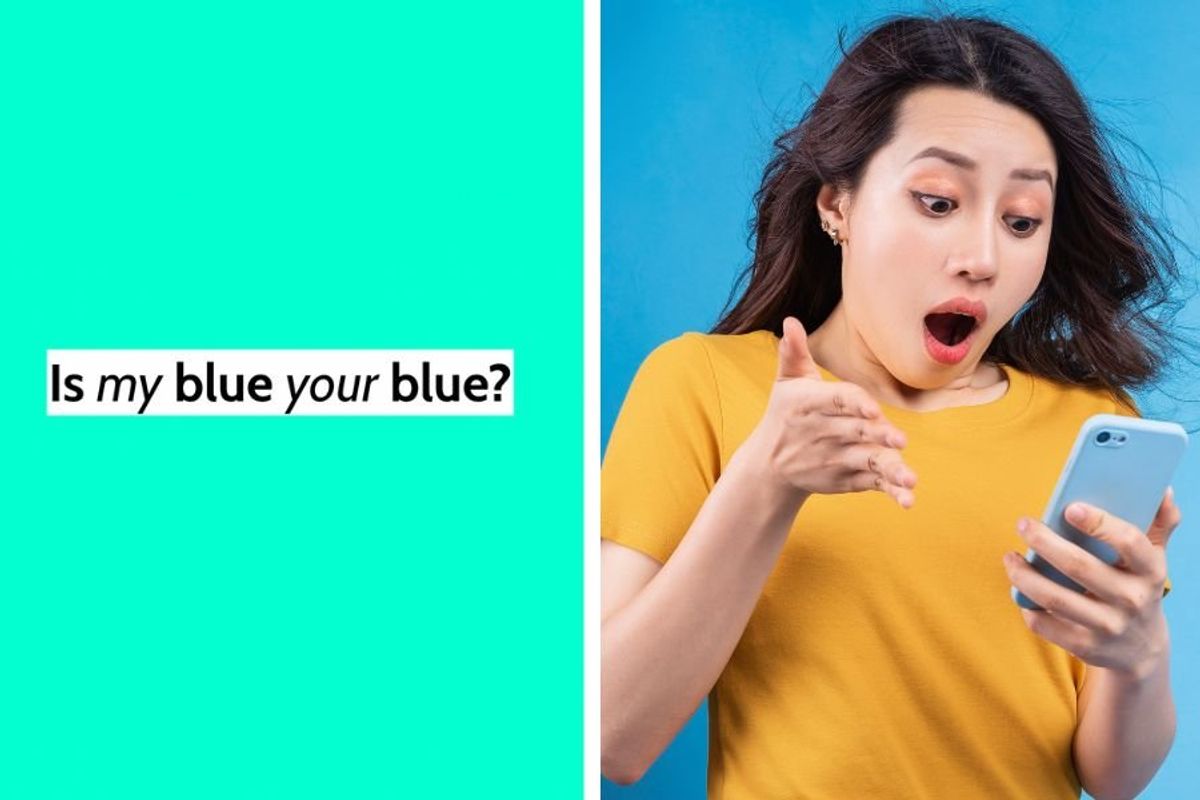Neuroscientist's 'color perception' test will make you never see blue or green the same way again
This is so much more than an optical illusion.

Thought turquoise was blue? Your eyes might think differently.
A new test going viral online shows how very different we all are at perceiving color—especially when it comes to blue and green.
Designed by neuroscientist Patrick Mineault, the “Is my blue your blue?” test shows where on the blue/green spectrum you perceive each color, and how that compares to the average percentage of other people who've taken the test.
It might seem like some kind of optical illusion, but rest assured, there’s no choosing between black and gold dresses here…though it’s still pretty mind boggling.
Taking the test is pretty straightforward. As soon as you head over to the ismy.blue website, you’ll be prompted to select whether the shades that pops up on the screen is blue, or green.
At first, the contrast between the two colors is easy to spot. But as time goes on, it gets a little more challenging to decide whether you’re looking at a greenish blue…or a blueish green.
Still, the test only takes a few seconds, after which you’ll be shown a gradient chart that compares your color perception with the rest of the world who have taken the test.
The test also reveals if you see turquoise as more of a blue or green color—which was certainly news to me. Unsurprisingly my results told me I see turquoise as blue. That’s because it is blue!!! But I digress.

Of course, Mineault admits that the test is “far from perfect,” and limited by factors such as “the calibration of your monitor, ambient lighting, and filters such as night mode.” He also reminds us that the finds are “for entertainment purposes only.”
But truly, it does feel entertaining to be able to say that “My boundary is greener than 90%” of the population, for some strange reason. And I’m not the only one, several folks have shared their own results on X—many of whom finally have a reason for all those color debates with friends and family.
For years people have called out my categorising of green and blue and told me I was colour blind - but I can see the colours perfectly well, I just categorise them weird - and it's nice to be vindicated, but also weird to see it spelled out like this.https://t.co/61nfsoKlnc pic.twitter.com/2RZ3GUb0cK
— Jay Hulme (@JayHulmePoet) September 3, 2024
As the About section of this test notes, many experts hypothesize that language plays a major factor in how we perceive and categorize colors. And this phenomenon, often referred to as language relativity, has been the source of several scientific studies.
In one classic study from 1969, anthropologists Brent Berlin and Paul Kay investigated the color vocabulary in 100 languages and found that color terms followed a predictable hierarchy. For instance, if a language had only two color words, the words would be the equivalent of “black” and “white.” If it has three, they would be “white,” “black” and “red”. With five terms, “green” and “yellow” were added to the mix. And so on. Their findings indicated that while color perception can be affected by outside factors, such as cultural influences, there is still a universal pattern involving six basic colors: white, black, blue, yellow, green and red.
All this to say—it’s amazing how we can all look at the same thing 9in this case, the same color) and our brains paint an entirely different picture. The fact that we have at least some semblance of consensus reality is truly baffling, when you think about it.
If you’d like to see just how your blues and greens stack up with the rest of the world, you can take the “Is my blue your blue?” test here.


 Joyful moments captured: A cheerful day out!
Joyful moments captured: A cheerful day out! Two generations connecting through their smartphones.
Two generations connecting through their smartphones. Elderly man working.
Elderly man working. animation love GIF
animation love GIF  "Grandparents are eternal."
"Grandparents are eternal."